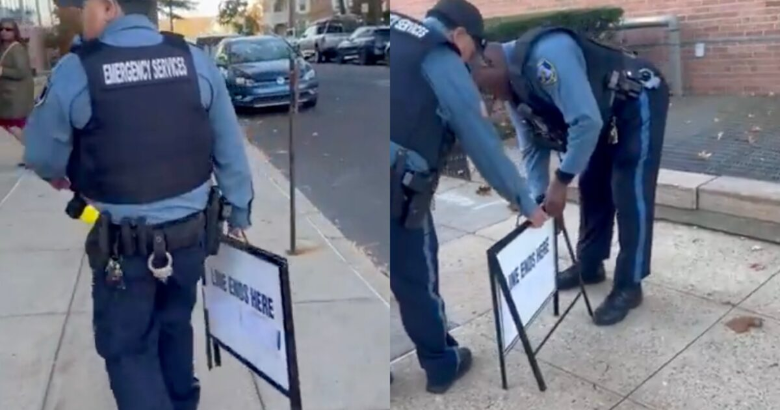In an unexpected shift that’s drawing national attention, President-elect Donald Trump won Springfield, Ohio, for the first time, securing a narrow victory in the city after years of Democratic dominance. Despite the heated backlash over his comments about Haitian migrants, Trump’s aggressive stance on immigration appears to have resonated with Springfield voters, helping him solidify support in the area and win Clark County by a record margin.
Trump’s recent statements about immigration stirred controversy nationwide. At a rally, he leaned into rumors that Haitian migrants arriving in Ohio were allegedly responsible for pet disappearances in Springfield. While many political commentators predicted this rhetoric might alienate voters, especially in more diverse urban centers, Trump maintained his position.
A September Politico article warned that his remarks could backfire, citing concerns among some Republican strategists who felt Trump’s rhetoric could be seen as divisive or sensationalist. Similarly, Newsweek suggested that backlash over Trump’s immigration stance might even affect his support among Haitian American communities, especially in swing states like Florida.
Despite these concerns, Trump doubled down, aligning his comments with his long-standing “America First” approach to immigration and border control, policies that have consistently resonated with his core supporters. By framing the issue as one of safety and community preservation, he reinforced his image as a leader willing to tackle immigration aggressively—even if it meant embracing controversial language.
Clark County, where Springfield is located, has been a reliable stronghold for Trump in past elections. He won the county by 57 percent in 2016, then increased his margin to 61 percent in 2020. However, Springfield itself has traditionally leaned Democratic, with Hillary Clinton winning the city by approximately 2,800 votes in 2016 and Joe Biden by around 1,800 votes in 2020. Even J.D. Vance, a Trump-aligned Republican, lost Springfield by 1,300 votes in his 2022 Senate campaign against Democrat Tim Ryan.
This election cycle saw an unexpected shift. Trump carried Springfield by a narrow margin of around 150 votes out of over 20,000 cast—a slim but significant victory in a city that had previously rejected his platform. Winning Springfield pushed Trump’s total share of the Clark County vote to 64 percent, a record high for a Republican presidential candidate in the area in over four decades.
Analysts have pointed to several factors that may have contributed to Trump’s success in Springfield this time around. While his immigration rhetoric might have sparked controversy, it also drew attention to broader concerns about border security, economic competition, and community safety—issues that resonate with many working- and middle-class voters who feel their concerns have been overlooked.
Moreover, Springfield, a city facing economic challenges and struggling with population decline, may have seen in Trump’s hardline immigration stance a message of protection and economic prioritization. Trump’s framing of immigration as a threat to jobs, resources, and community stability struck a chord with residents worried about economic insecurity and crime.
According to political strategist Mark Stover, Trump’s messaging was particularly effective in cities like Springfield because it tapped into sentiments of dislocation and anxiety. “Trump is good at targeting communities that feel overlooked by the broader political establishment. He speaks directly to their fears about economic erosion, which he links to immigration and globalization,” Stover said. This strategy, while polarizing, has proven effective at galvanizing Trump’s base, particularly in regions facing economic challenges.
Trump’s success in Springfield wasn’t just symbolic—it helped him achieve a record margin of victory in Clark County. Securing 64 percent of the county vote, Trump set a new benchmark for Republican candidates, a margin that may be hard for future GOP hopefuls to match. His strong showing in the county adds to a pattern of increasing support among rural and suburban voters in Ohio, reflecting a broader trend that has helped Republicans consolidate power in the state in recent election cycles.
Political experts have noted that Trump’s gains in Clark County are significant for his overall strategy. His approach of pushing hard on key cultural issues has consistently energized his base, particularly in areas where residents feel a lack of economic opportunity and are receptive to his promises of revitalization and “draining the swamp.” Clark County, as a blend of suburban and semi-rural demographics, epitomizes this trend.
Winning Springfield signals that Trump’s focus on “law and order” and aggressive immigration policies may be giving him an edge in regions that previously leaned blue. His victory in Springfield could prompt his campaign to double down on similar messaging in other battleground areas, hoping that a mix of economic populism and cultural conservatism will deliver additional gains in traditionally Democratic-leaning locales.
Some political analysts, however, caution that Trump’s gains in Springfield could be short-lived. His rhetoric, while effective in the short term, could alienate moderate Republicans and independents in other regions. For now, however, Trump’s Springfield victory has shown that his approach to immigration—though divisive—resonates with a segment of voters who feel unheard by the political establishment.
As Trump prepares to take office again, his surprising win in Springfield, Ohio, has offered a glimpse into how he might reshape his strategy for 2024, potentially focusing on smaller urban areas where his message of economic protectionism and cultural conservatism could turn the tide. Whether this strategy will yield similar gains in other traditionally Democratic areas remains to be seen, but Trump’s unexpected victory in Springfield is already shaping the narrative around his post-2024 presidency.


